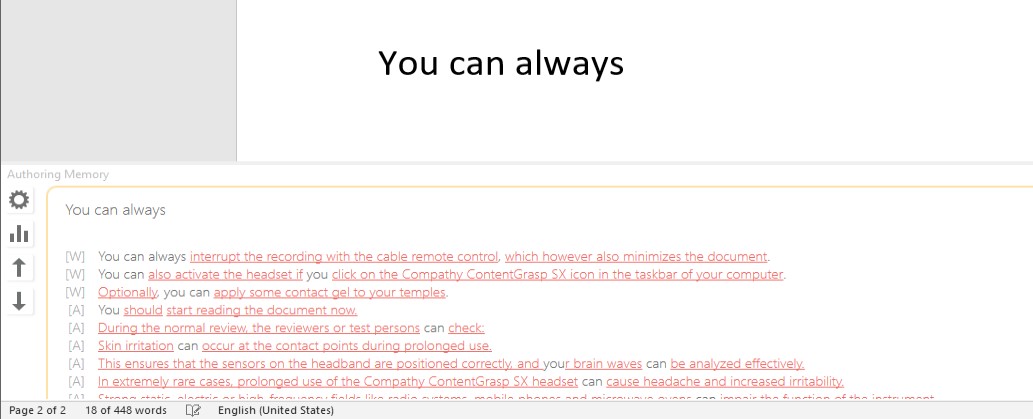Autocomplete when Writing
In simple terms, an authoring memory is a database with text units in a language. Technically, a translation memory is used for this purpose.
When the author writes the beginning of a sentence, the authoring memory is searched for content that starts with the same initial words or at least contains these words. This function offers the author an autocomplete function that provides texts that have already been checked and possibly translated.
Reuse of Sentences
The Authoring Memory panel presents the author with the most similar sentences in the memory for each sentence in the current document, with differences clearly highlighted. The panel also shows how many languages all sentences in the memory have already been translated into.
The matching report enables convenient filtering in order to specifically identify those sentences in a batch check that have a match of almost 100% in the memory.

Reduce Translation Costs
Translation costs are saved at the source. If a company publishes its content in 30 languages, using a sentence that has already been translated saves the translation into 30 languages. In everyday life, however, it is usually the case that new variants of content are created instead of high reuse rates. Variants arise when new content is created but there are linguistic differences to existing sentences. This can involve the following phenomena, for example: Abbreviations, spaces, punctuation, linguistic errors, formulation variants or inconsistent terminology.
A practical example of a successful reduction of variant diversity comes from Daimler AG. When setting up an authoring memory, the initial 750,000 sentences were reduced to 122,000 sentences by eliminating unnecessary variants. By using the authoring memory and a corresponding function for managing records, the number of variants is further reduced (see https://www.congree.com/wissen/halbzeit-ohne-verschnaufpause - only available in German).
Building the Authoring Memory
There are various approaches to filling the authoring memory when using Congree UCC for the first time. Some companies prefer to start with an empty authoring memory, as they expect the appropriate content quality for the entries only after the implementation of Congree UCC. Other companies prefer to use content that has already been released to initialize the authoring memory. This can include elements from a translation memory, a content management system (CMS) or a selected collection of documents. The content intended for import can be subjected to either fully automatic or semi-automatic data cleansing to ensure high quality entries.
Continuous Filling
There are also various options for filling the authoring memory with newly created content during operation. The corresponding options can be set by the platform administrators. Authors can, for example, transfer new sentences directly from their writing environment to the memory. This option is known as hive authoring. The Congree Gatekeeper function is used to automatically reject sentences that have predefined linguistic deficiencies. Filling can also be carried out using an automatic process that is linked to approval in the CMS or an initial translation in the translation management system. The more comprehensive method is the Sentence Life Cycle Workflow, in which all new sentences are submitted to a group of content supervisors in the Congree Data Grooming module for approval.
Cross-Departmental and Cross-Tool Access
An authoring memory can also support collaboration between departments. Departments, e.g. technical documentation, training or support, often work with different tools, but would like to be able to access the content of the other department. Shared access is made possible by authoring memory software that can be used in many different text creation programs.
Recommended Reading
Use of Authoring Memory
Knowledge
Unleashing the Power of the Authoring Memory
- Authoring Memory
Knowledge
Content Economics: the ROI of Content Reuse
- Authoring Memory



